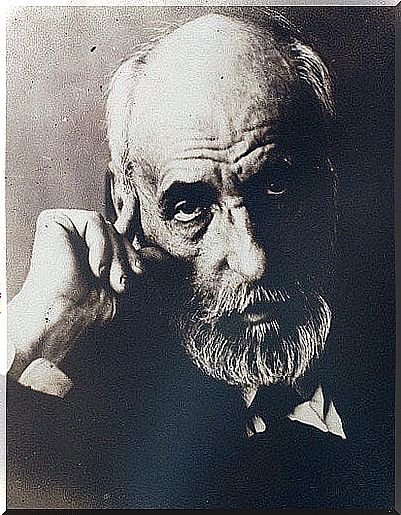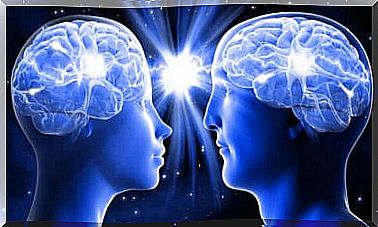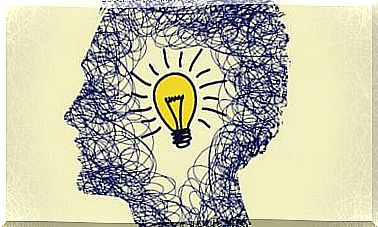Cognitive Neuroscience: Understanding The Behavior Of The Mind

Traditionally the goal of neuroscience is to understand the functioning of the nervous system. This discipline tries to understand how the brain is organized on a functional and structural level. In recent times, however, we have gone further, we do not want to know only how the brain works, but also the repercussions that this has on our behavior, on our thoughts and emotions.
The goal of relating the brain to the mind is a task of cognitive neuroscience, which is a discipline that combines neuroscience and cognitive psychology. The latter deals with studying higher functions such as memory, language or attention. The main objective of cognitive neuroscience, therefore, is to relate the functioning of the brain with our cognitive abilities and our behaviors.
The development of new techniques has been of great help in this field to be able to carry out experimental studies. Neuro-imaging studies have facilitated the task of relating concrete structures with different functions, using a very useful tool for this purpose: functional magnetic resonance. In addition, other tools have also been developed such as non-invasive transcraneal magnetic stimulation for the treatment of various pathologies.
The birth of neuroscience
We cannot talk about the birth of neuroscience without mentioning Santiago Ramón y Cajal, the one who formulated the theory of neurons. His contribution to the problems of the development, degeneration and regeneration of the nervous system are still current and are still taught in the faculties. If neuroscience is to be given a date of birth, it would be in the 19th century.

With the development of the microscope and experimental techniques such as tissue fixation and staining or the study of the structures of the nervous system and their functionality, this discipline began to develop. However, neuroscience has received contributions from numerous areas of study that have helped to better understand how the brain works. It can therefore be said that subsequent neuroscientific discoveries are multidisciplinary.
They have received a great contribution from anatomy, which is concerned with locating every part of the organism. From physiology, more focused on understanding how our body works. From pharmacology, with substances foreign to our body, observing the repercussions of these on the body and biochemistry, using substances secreted by the body, such as neurotransmitters.
Psychology has also made an important contribution to neuroscience, through behavioral theory and thinking. Over the years, the vision has shifted from a localizing perspective, in which each area of the brain was thought to have a concrete function, to a more functional one, in which the goal is to understand the global functioning of the brain.
Cognitive neuroscience
Neuroscience encompasses a very broad spectrum of sciences. Starting from basic research, up to applied research that works with the repercussion of behavior-dependent mechanisms. Within neuroscience lies cognitive neuroscience which seeks to discover how higher functions such as language, memory or decision making operate.
Cognitive neuroscience has as its main objective the study of the nervous representations of mental acts. It focuses on the neuronal substrates of mental processes, i.e. what repercussions does what happens in the brain have on our behavior and our thinking? Specific areas of the brain in charge of sensory or motor functions have been identified, but these represent only a fourth part of the total cortex.

The areas of association, which do not have a specific function, are those responsible for interpreting, integrating and coordinating the sensory and motor functions. They would be responsible for higher mental functions. The brain areas that govern the functions of memory, thought, emotions, consciousness and personality are much more difficult to locate.
Memory is linked to the hippocampus, which is located in the center of the brain. As for emotions, the limbic system is known to control thirst and hunger (hypothalamus), aggression (the amygdala) and emotions in general. It is in the cortex that cognitive abilities are integrated, the place where our ability to be conscious, to establish relationships and do complex reasoning is found.
Brain and emotions
Emotions are one of the essential characteristics of normal human experience, we all feel them. All emotions are expressed through visceral motor changes and stereotyped somatic and motor responses, especially movements of the facial muscles. Traditionally emotions were attributed to the limbic system, this theory is still in vogue today, but there are other brain regions involved.
The other areas to which the emotional process extends are the amygdala and the orbital and median source of the frontal lobule. The joint and complementary action of these areas constitutes an emotional motor system. The same structures that process emotional signals participate in other tasks, such as the ability to make rational decisions and also to establish moral judgments.

Visceral nuclei and somatic motors coordinate the expression of emotional behavior. Emotions and the activation of the autonomic nervous system are intimately linked. Feeling any kind of emotion, such as fear or surprise, would be impossible without experiencing an increase in heart rate, sweating, trembling… It is part of the richness of emotions.
Attributing emotional expression to brain structures gives it its innate naturalness. Emotions are an adaptive tool that informs others about our state of mind. The homogeneity of expressions of joy, sadness, anger… in different cultures has been demonstrated. It is one of our ways of communicating and empathizing with others.
Memory: the storehouse of the brain
Memory is a basic psychological process that alludes to the coding, storage and retrieval of learned information. The importance of memory in our daily life has given rise to several researches on this topic. Another central theme of many studies is forgetfulness, as many diseases cause amnesia, which severely interferes with daily life.
The reason why memory is such an important topic is that a large part of our identity resides in it. On the other hand, even if forgetfulness in the pathological sense causes us concern, we know that the brain needs to get rid of useless information in order to receive new learning and meaningful information. In this sense, the brain is an expert in recycling its resources.
Neuronal connections change with their use or non-use. When we hold back information that is not being used, neuronal connections are weakening until they disappear. Likewise, when we learn something new, we create new connections. Any learning that we can associate with other notions or life events will be easier to remember.
Knowledge of memory has increased following a study of people with very specific amnesia. It helped to learn more about short-term memory and declarative memory consolidation. The famous HM case highlighted the importance of the hippocampus in establishing new memories. Recollection of motor skills, on the other hand, is controlled by the cerebellum, primary motor cortex, and basal ganglia.
Language and speech
Language is one of the skills that differentiates us from the rest of the animal kingdom. The ability to communicate with such precision and the large amount of ways we have to express thoughts and feelings makes language our richest and most useful communication tool. This unique feature of our species has caused a lot of research to focus on it.

The successes of human culture are based, in part, on language, which allows for precise communication. Linguistic ability depends on the integrity of the various specialized areas of the association cortices in the temporal and frontal lobes. In most people, the primary functions of language are found in the right hemisphere.
The right hemisphere would deal with the emotional content of language. Specific damage to brain regions can compromise essential language functions, eventually causing aphasia. Aphasias can have very different characteristics, you can have difficulties both in articulation and in the production or understanding of language.
Neither language nor thought is supported by a single concrete zone, rather by an association of different structures. Our brain works in such an organized and complex way that when we think or speak, it makes multiple associations between the tasks it is carrying out. Our previous knowledge will affect new ones, in a backfeed system.
Great discoveries of neuroscience
Describing all relevant studies in neuroscience would be a complicated and very extensive task. The following findings ousted some past ideas about how our brains work and sparked new studies. This is a selection of some important experimental studies among the thousands of existing works:
- Neurogenesis (Eriksson, 1998). Until 1998 it was thought that neurogenesis occurs only during the development of the nervous system and that after this period neurons die, without being produced again. After Erikkson’s experiments, however, it was found that neurogenesis also occurs in old age. The brain is more plastic and malleable than previously thought.
- Contact during early childhood and cognitive and emotional development (Lupien, 2000). In this study, the importance of physical contact of the child during his early childhood was demonstrated. Children who have had little physical contact are the most vulnerable to functional cognitive deficits that generally manifest themselves in depression or high-stress situations and which mainly concern attention and memory.
- The discovery of mirror neurons (Rizzolatti, 2004). This study was initiated by the ability of newborn babies to imitate the gestures of others. This led to the discovery of mirror neurons, neurons that are activated when we see a person perform an action. They facilitate not only imitation, but also empathy and, therefore, social relations.
- Cognitive reserve (Petersen, 2009). The discovery of cognitive reserve has been very relevant in recent years. According to this theory, the brain is able to compensate for injuries. This ability is influenced by various factors such as the age of schooling, the work done, the reading habits or the social circle. A high cognitive reserve can compensate for the damage in diseases such as Alzheimer’s.
The future of neuroscience: “Human brain project”
The Human Brain Project is a project funded by the European Union which aims to build an infrastructure based on information and communication technologies (ICT). This infrastructure aims to make a database in the field of neuroscience available to all scientists in the world. Develop six ICT-based platforms:
- Neuro-informatics : it will give access to the data of neuroscientific studies carried out all over the world.
- Brain simulation : it will integrate information into unified computer models to carry out tests that would not be possible to do in person.
- High-throughput Computing : It will deliver the interactive super-computation technology that neuroscientists need for modeling and simulating data.
- Neuro-computer spelling : it will transform brain models into “hardware” devices by testing their applications.
- Neuro-robotics : will allow neuroscience and industrial researchers to experiment with virtual robots controlled by brain models developed in the project.

This project started in October 2013 and will have an estimated duration of 10 years. The data that will be collected in this huge database will facilitate the work of future research. The advancement of new technologies is allowing scientists to have a deeper understanding of the brain, although basic research still has many doubts to resolve in this exciting field.
Bibliography
Eriksson, PS, Perfilieva E., Bjork-Eriksson T., Alborn AM, Nordborg C., Peterson DA, Gage F., Neurogenesis in the Adult Human Hippocampus, Nature Medicine. 4 (11), 1998, 1313–1317.
Kandell ER, Schwartz JH y Jessell TM, Principles of neuroscience, Milan, CEA, 2013
Lupien SJ, King S., Meaney MJ, McEwen BS, Child’s stress hormone levels correlate with mother’s socioeconomic status and depressive state, Biological Psychiatry, 2000, 48, 976–980.
Purves, Augustine, Fitzpatrick, Hall, Lamantia, McNamara y Williams., Neuroscience, Milan, Zanichelli, 2013
Rizzolatti G., Craighero L., The mirror-neuron system. Annual Review of Neuroscience, 2004, 27, 169–192.
Stern, Y., Cognitive reserve, Neuropsychologia, 2007, 47 (10), 2015–2028.









